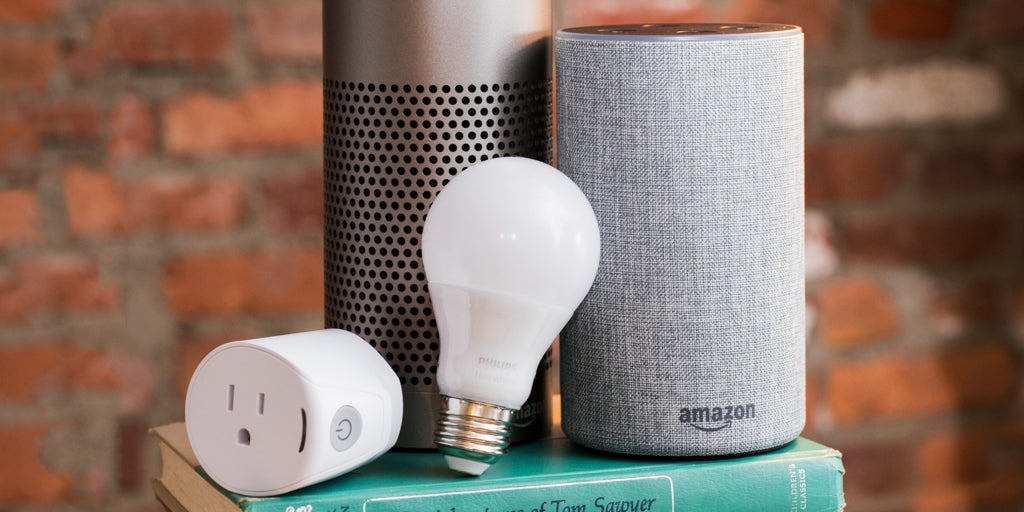
There was a time when home automation was a kind of laboratory experiment, requiring a working knowledge of networking methods, esoteric gear, and a hefty investment just to get started. Now you can test the smart-home waters with easy-to-use and inexpensive gear, learn what you like about it, and then expand your collection without much fear of your devices’ refusing to work together (or everything ending in tears). For the smart-home-curious who just want a set-it-and-forget-it experience, here are some devices we think anyone can use and appreciate. None of these devices require any more setup than plugging them in and then downloading a corresponding app. Once you get accustomed to your new devices, you can start connecting them to other things and find new ways to use them.
All of the smart devices here support easy expansion, so you can start with one bulb or plug and then add a smart speaker—and before long you’ll have a house full of smart devices, all controlled by voice, opening up all kinds of possibilities.
Smart bulbs
Smart bulbs are some of the easiest and most practical connected devices you can add to your home. They require no expertise other than the ability to tap a password into an app, and they instantly let you wirelessly control nearly any light in your home. Many allow you to make Schedules or Routines in the app that will automatically turn the lights on and off at the brightness setting of your choosing. Our favorite smart bulbs can also change color, allowing you to transform the look of your room on a whim.
Smart bulbs range in price from about $10 for a basic white bulb from Wyze to around $50 for a color-adjustable bulb from the Philips Hue line. All smart bulbs are wireless, but different models may use different wireless signals, including Wi-Fi, Zigbee, and Bluetooth. Bulbs connected directly to your Wi-Fi network, such as the Wyze bulbs, are the easiest to set up, but Zigbee-connected bulbs like those from the Philips Hue line may be better for larger homes where Wi-Fi can’t reach into every corner. Bluetooth-connected bulbs are fine to use within a single room, but once you’re out of Bluetooth range (a few dozen feet), you won’t be able to control the light, so we don’t recommend them for many people. Most smart bulbs come in the standard A19 format, but sconce-style lights and floodlights are also available.
Smart plugs
If you want to control a lamp, a fan, or even an air conditioner, a smart plug can give you wireless control over the appliance. Smart plugs are small adapters that plug into a standard AC wall outlet and that you then plug your appliance into, thus giving you control via a smartphone app. A smart outlet doesn’t usually give you as much control over a lamp as you’d have with a smart bulb, but you can turn the lamp on and off wirelessly, put it on a Schedule, or group it with other smart plugs so that you can control several lamps at once. A few, including the Lutron Caséta plug, allow you to dim the lights. And you can even find outdoor smart plugs, like the TP-Link Kasa Smart Wi-Fi Outdoor Plug, that let you control things outside. Many people find smart plugs especially handy for controlling holiday lights and decorations, including those abominable blow-up yard decorations.
If you’re looking for a basic and affordable smart plug, we like the Wyze Plug, which comes in a two-pack for about $20. If you want to plug in a number of devices at a time, such as several strings of holiday lights, the TP-Link Kasa Smart Wi-Fi Power Strip has six AC inputs, each of which you can control independently.
Smart speakers
Many people get smart speakers, such as the Amazon Echo or Google Nest Hub, for playing music, checking the weather, hearing terrible jokes, or keeping in touch with family. But a smart speaker is also a critical and easy-to-use component of a smart-home system. Think of it as the universal remote for your smart home. Most popular smart-home devices (including the light bulb and plug we mention above) can integrate with a smart speaker, allowing you to control your lights with a voice command, for instance, as well as to create Automations (often called Routines) to control several things at once. For example, you might program your smart speaker to turn on the kitchen light, start an electric tea kettle, and play your morning news report when you say “Good morning.” It’s an impressive amount of home-automation power that’s easy and inexpensive to set up.
Among smart speakers, we prefer Amazon’s Echo line because it’s compatible with more smart-home devices than Google Nest or Apple smart speakers and offers more models to choose from. The Echo Dot, usually priced below $50, is a great model to start with. Or, if you’re especially into cooking, you could try the Google Nest Hub (2nd Gen) or its larger sibling, the Nest Hub Max—either model’s built-in display makes it a great helper in the kitchen.
